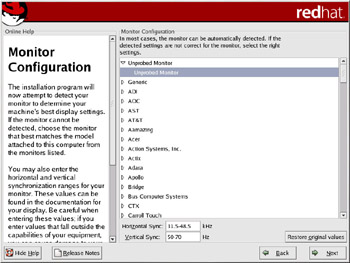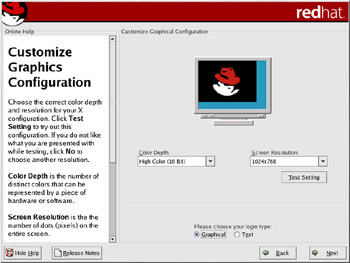X Configuration: Monitor and Customization
|
In order to complete X configuration, you must configure your monitor and customize your X settings. If you chose to skip X configuration, go to the next section., “Configuring Your Monitor.”
Configuring Your Monitor
The installation program will present you with a list of monitors to select from. From this list, you can either use the monitor that is automatically detected for you, or choose another monitor.
| Note | If you are installing Red Hat Linux on a laptop with an LCD screen, select the most appropriate Generic model available. |
If your monitor does not appear on the list, select the most appropriate Generic model available. If you select a Generic monitor, the installation program will suggest horizontal and vertical sync ranges. These values are generally available in the documentation that accompanies your monitor, or from your monitor’s vendor or manufacturer; please check your documentation to make sure these values are set correctly.
| Warning | Do not select a monitor similar to your monitor unless you are certain that the monitor you are selecting does not exceed the capabilities of your monitor. Doing so may overclock your monitor and damage or destroy it. |
The horizontal and vertical ranges that the installation program suggests for the selected monitor are also displayed below the list of monitors. If you decide that your monitor selection or the horizontal and vertical ranges are incorrect, you can click the Restore original values button to return to the original suggested settings. Click Next when you have finished configuring your monitor.
Custom Configuration
Choose the correct color depth and resolution for your X configuration. Click Test Setting to try out this configuration. If you do not like what you see during the test, click No to choose another resolution.
| Note | If you need to exit the X configuration test, use the Ctrl-Alt-Backspace key combination. This will not work in some test cases. |
It is recommended that you test your configuration to make sure the resolution and color settings are usable. You can also choose whether you want to boot your system into a graphical or text environment once the installation is complete. Unless you have special needs, booting into a graphical environment (similar to a Windows environment) is recommended. If you choose to boot into a text environment, you will be presented with a command prompt (similar to a DOS environment).

Figure A-35: Monitor selection
| Tip | To change your X configuration after you have completed the installation, use the X Configuration Tool. Type the redhat-config-xfree86 command at a shell prompt to launch the X Configuration Tool. If you are not root, it will prompt you for the root password to continue. |
| Tip | To change your X configuration after you have completed the installation, use the X Configuration Tool. Type the redhat-config-xfree86 command at a shell prompt to launch the X Configuration Tool. If you are not root, it will prompt you for the root password to continue. |
|
EAN: 2147483647
Pages: 278
- Challenging the Unpredictable: Changeable Order Management Systems
- ERP System Acquisition: A Process Model and Results From an Austrian Survey
- Data Mining for Business Process Reengineering
- A Hybrid Clustering Technique to Improve Patient Data Quality
- Relevance and Micro-Relevance for the Professional as Determinants of IT-Diffusion and IT-Use in Healthcare
